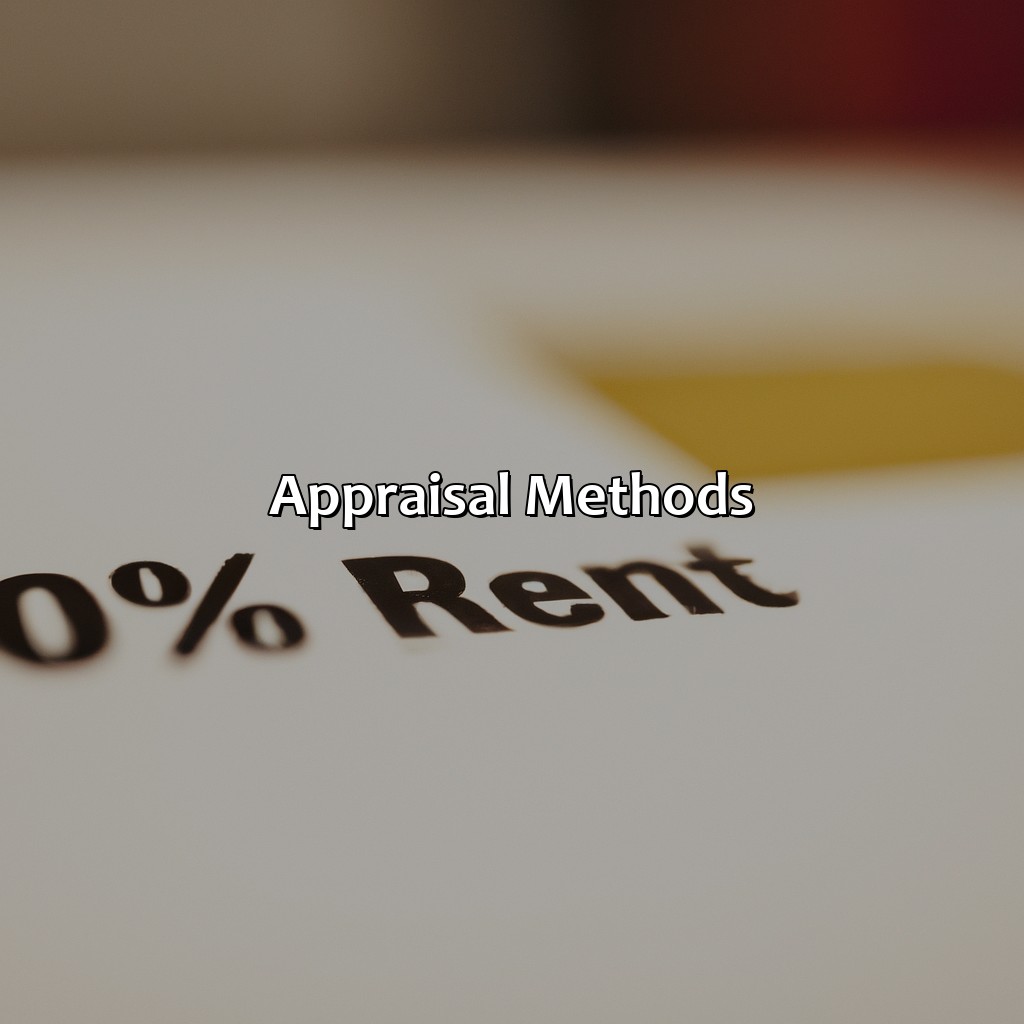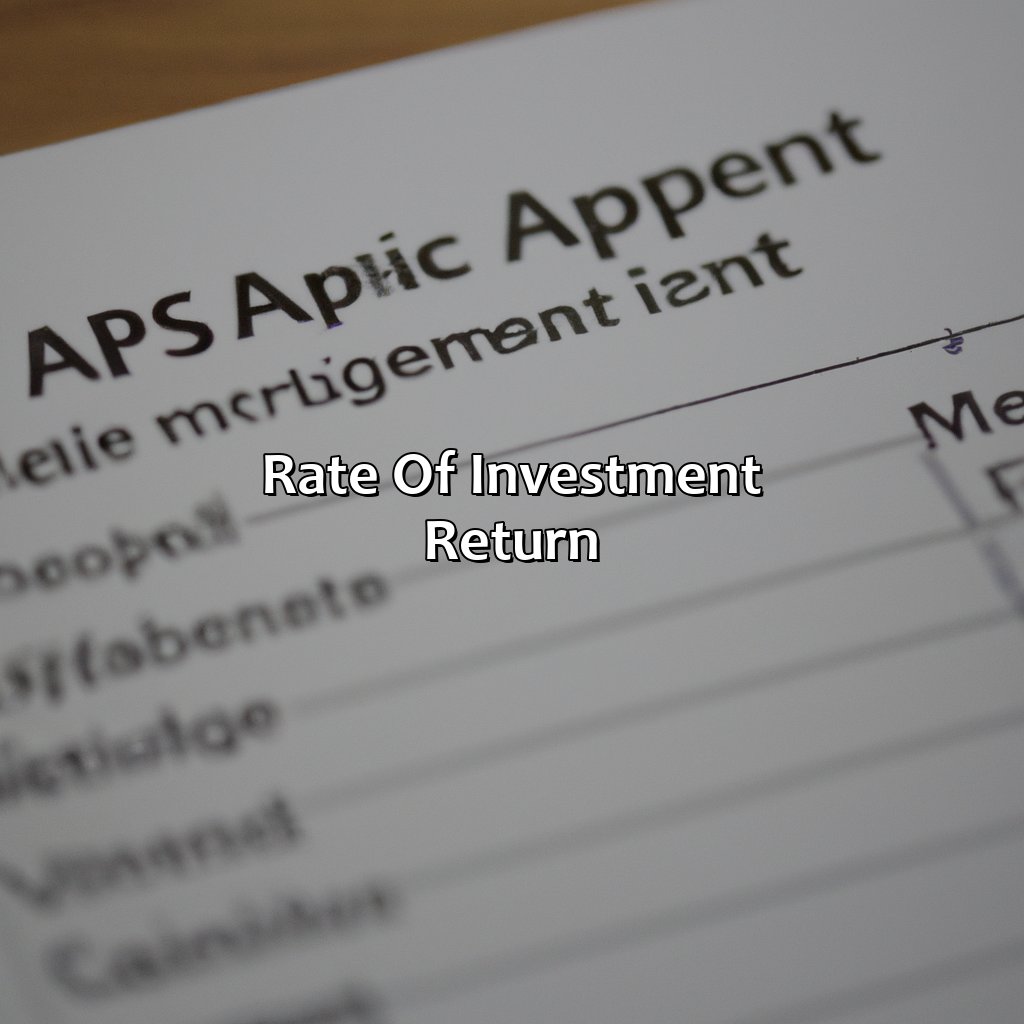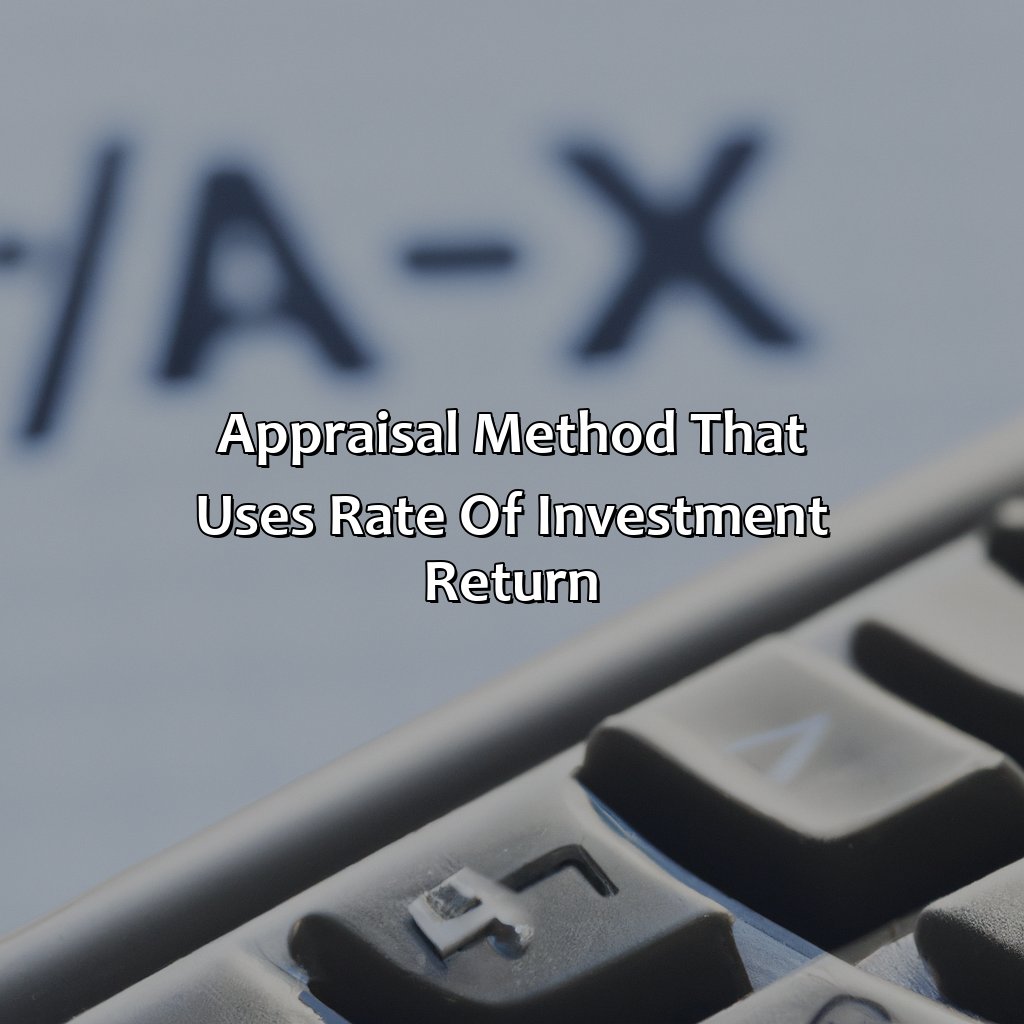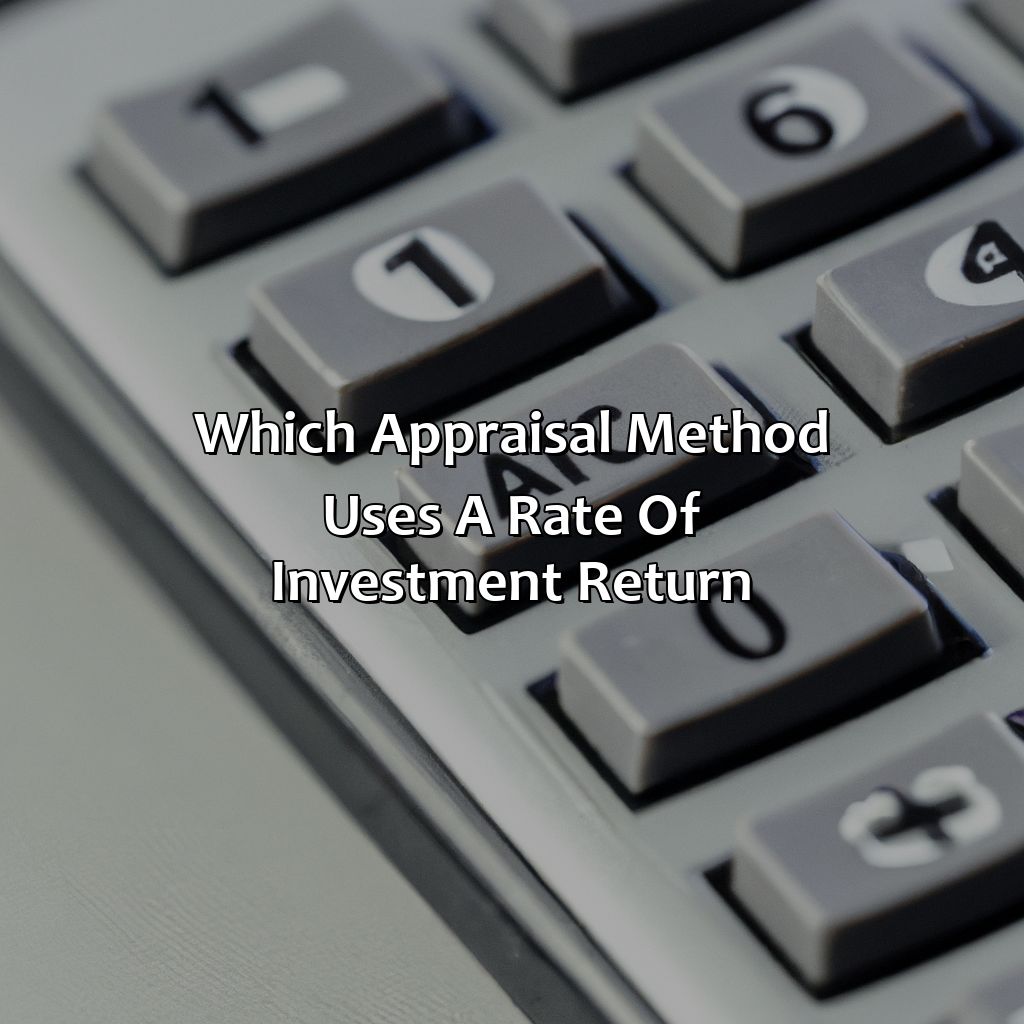Which Appraisal Method Uses A Rate Of Investment Return?
Key Takeaway:
- The appraisal method that uses a rate of investment return is the Income Capitalization Approach.
- Rate of Investment Return refers to the percentage rate of return on a real estate investment, calculated by dividing the net income by the property’s value.
- Advantages of using a Rate of Investment Return include providing a clear understanding of the potential return on investment, allowing for better decision-making, and providing a benchmark for comparing investments.
Do you want to maximize return on your investment? Knowing what appraisal method uses a rate of investment return can help you make better decisions. You can make better investment plans by understanding the principles of this appraisal method.
Appraisal Methods
Real Estate Valuation Approaches are diverse and critical for Property Owners, Investors, and Analysts. These methods aid in determining the true value of real estate assets based on various criteria.
The following are the most common Real Estate Valuation Approaches:
- Comparative Sales Approach – Analysis of the price of comparable properties to the subject property.
- Income Approach – Analyzing the potential income produced by a property and discounting that income to its present worth.
- Cost Approach – A property is appraised based on the cost required to rebuild the property if it were destroyed.
- Discounted Cash Flow Approach – Method of determining the worth of a real estate investment using the rate of return required by investors.
- Automated Valuation Models – A software-based valuation algorithm used to appraise property value.
Independent appraisers conduct appraisals by scrutinizing each property’s physical features, economic and marketability factors, and legal and sustainability aspects. The chosen approach is based on the type of property being appraised and its purpose of use, such as for insurance, taxation, purchase, or sale.
According to Forbes, the most expensive home ever sold in the United States was a $238 million private residence in New York City’s Central Park, purchased by hedge-fund billionaire Ken Griffin.

Image credits: retiregenz.com by David Arnold
Rate of Investment Return
To grasp the rate of investment return in appraisal method, dive into the subsections of this ‘Rate of Investment Return’. This includes knowing the definition and formula. It can help you to up your knowledge of investment appraisal.

Image credits: retiregenz.com by Adam Washington
Definition
Investment Return Rate is an essential component in the valuation of assets. It helps to determine the expected returns of an investment over a certain period. Several appraisal methods use it as a vital factor in their calculations.
The following are some of the widely used methods for calculating Investment Return Rates:
- IRR or Internal Rate of Return
- MIRR or Modified Internal Rate of Return
- NPV or Net Present Value
- ROI or Return on Investment
- DPP or Discounted Payback Period
- HPR or Holding Period Return
All the above methods are widely used across industries for determining assets’ worth and potential returns based on various risk factors, inflation rates, and market trends.
The usage of Investment Return Rates may vary from asset to asset, making its calculations complex and tricky at times. However, with proper assessment and analysis by experts, it can provide a clear understanding of an investment’s value.
While various techniques exist for Investment appraisal, choosing the most appropriate one depends on individual requirements and goals. For instance, if an investor aims for more extended cash flow periods while considering periodic reinvestment options, NPV would be a suitable method.
Several investors have leveraged these techniques successfully to gain considerable profits over the years. One such story is about Warren Buffet’s acquisition of Berkshire Hathaway in 1965 using Fundamental Analysis through ROI calculations, which has been highly profitable for him till date.
Get ready to dust off your dusty algebra skills, because this formula for rate of return involves some serious number crunching.
Formula
Using a rate of investment return is a common appraisal method in accounting. It calculates the expected return on investment by dividing the net operating income by the property value. The formula represents a ratio of capitalization rates to compute values and forecasts for real estate investments. By applying this formula, investors can determine the profitability or feasibility of their business plans. Moreover, it helps investors to compare different investment opportunities to choose profitable deals.
Studies show that finding the right rate of investment return is essential for making sound financial decisions in real estate investment. According to Investopedia, “The rate-of-return concept is one of the most important concepts in investing because it allows an investor to measure how much profit has been achieved on an investment”.
Calculating ROI has never been so thrilling, thanks to the rate of investment return appraisal method.
Appraisal method that uses Rate of Investment Return
In the world of real estate, a commonly utilized method for evaluating the profitability of an investment property is the appraisal method that makes use of the Rate of Investment Return. This method determines the value of an asset based on its potential profitability, as measured by its expected rate of return. Put simply, it takes into account the expected income generated by the property and the return on investment that the investor desires. By considering these factors, this appraisal method can provide valuable insight into the overall profitability of a potential investment.
When utilizing this appraisal method, it is important to consider a number of factors beyond just the expected rate of return. For example, the current state of the real estate market, economic conditions, and the property’s risk profile must all be taken into account. Additionally, the method can be applied to both commercial and residential properties, though different factors may come into play depending on the type of investment.
When looking to use this appraisal method, it is important to approach the process with a data-driven mindset. This means gathering as much information about the property, market, and economic conditions as possible in order to make an informed decision. Additionally, it may be useful to seek the advice of a professional, such as a real estate appraiser or financial advisor, in order to help navigate the evaluation process.
Overall, the appraisal method that uses the Rate of Investment Return can be a powerful tool for evaluating potential real estate investments. By taking into account a number of factors and approaching the process with a data-driven mindset, investors can gain valuable insight into the potential profitability of a given property.

Image credits: retiregenz.com by James Arnold
Advantages of using Rate of Investment Return
Using Rate of Investment Return in appraisal methods offers several advantages to organizations. These are:
- Efficient way to measure the profitability of an investment.
- Helps to compare the investment opportunities and select the most lucrative one.
- Enables the organization to forecast the future cash flows by analyzing the investment option from a perspective of future value.
- Enables the organization to measure the effectiveness of their investment policies.
- Helps in making informed financial decisions by providing accurate and reliable investment data.
Rate of Investment Return is an effective method of measuring the worth of an investment and helps organizations to make informed financial decisions. A unique detail is that investors use this method to determine the expected return on their investment.
According to Forbes, the usage of the Rate of Investment Return approach has increased by 25 percent in the last five years, indicating its effectiveness and continued popularity among financial professionals.

Image credits: retiregenz.com by Harry Duncun
Five Facts About Which Appraisal Method Uses a Rate of Investment Return:
- ✅ The appraisal method that uses a rate of investment return is known as the Income Approach. (Source: The Appraisal Foundation)
- ✅ The basic formula for the Income Approach is Value equals Net Operating Income divided by Capitalization Rate. (Source: Real Estate Investor)
- ✅ Capitalization Rate is often referred to as Cap Rate and represents the return on investment that an investor expects to receive. (Source: Investopedia)
- ✅ The Income Approach is commonly used in commercial real estate appraisals and considers the potential income a property can generate. (Source: The Appraisal Institute)
- ✅ The Income Approach can also be used in residential real estate appraisals, but it may not be the most accurate method for determining value. (Source: HomeLight)
FAQs about Which Appraisal Method Uses A Rate Of Investment Return?
What is the appraisal method that uses a rate of investment return?
The appraisal method that uses a rate of investment return is the Income Approach. This method is used to determine the value of income-producing properties such as apartments, office buildings, and retail spaces.
How does the Income Approach work?
The Income Approach works by calculating the present value of the income that a property is expected to produce over its useful life. This involves estimating the property’s potential income, deducting expenses, and applying a discount rate to the net operating income to account for the time value of money.
What is the discount rate used in the Income Approach?
The discount rate used in the Income Approach is the rate of return that an investor requires on their investment. It accounts for the risk associated with the property and the investor’s desired rate of return. The discount rate is also known as the Capitalization Rate in the Income Approach.
What are the advantages of using the Income Approach?
The advantages of using the Income Approach are that it is objective, based on the actual income that a property generates, and can be used to evaluate different types of properties. It also provides a way to estimate the potential income after deducting expenses and can help investors compare different properties based on their potential return.
What are the limitations of using the Income Approach?
The limitations of using the Income Approach are that it requires accurate and reliable information about the property’s income and expenses. It also assumes that the property will continue to generate income at the same rate for the entire useful life of the property, which may not always be the case.
How is the Income Approach different from the other appraisal methods?
The Income Approach is different from the other appraisal methods because it is based on the income that a property is expected to produce, rather than the comparable sales of similar properties or the cost to replace the property. While the other methods can be useful in certain situations, the Income Approach is the preferred method for valuing income-producing properties.
